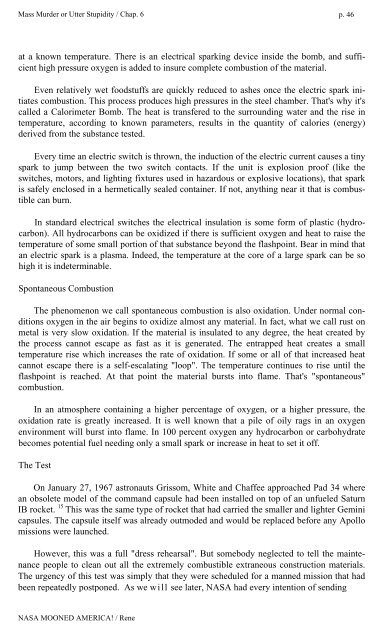Rene-NASA-Mooned-America
Rene-NASA-Mooned-America
Rene-NASA-Mooned-America
You also want an ePaper? Increase the reach of your titles
YUMPU automatically turns print PDFs into web optimized ePapers that Google loves.
Mass Murder or Utter Stupidity / Chap. 6 p. 46<br />
at a known temperature. There is an electrical sparking device inside the bomb, and sufficient<br />
high pressure oxygen is added to insure complete combustion of the material.<br />
Even relatively wet foodstuffs are quickly reduced to ashes once the electric spark initiates<br />
combustion. This process produces high pressures in the steel chamber. That's why it's<br />
called a Calorimeter Bomb. The heat is transfered to the surrounding water and the rise in<br />
temperature, according to known parameters, results in the quantity of calories (energy)<br />
derived from the substance tested.<br />
Every time an electric switch is thrown, the induction of the electric current causes a tiny<br />
spark to jump between the two switch contacts. If the unit is explosion proof (like the<br />
switches, motors, and lighting fixtures used in hazardous or explosive locations), that spark<br />
is safely enclosed in a hermetically sealed container. If not, anything near it that is combustible<br />
can burn.<br />
In standard electrical switches the electrical insulation is some form of plastic (hydrocarbon).<br />
All hydrocarbons can be oxidized if there is sufficient oxygen and heat to raise the<br />
temperature of some small portion of that substance beyond the flashpoint. Bear in mind that<br />
an electric spark is a plasma. Indeed, the temperature at the core of a large spark can be so<br />
high it is indeterminable.<br />
Spontaneous Combustion<br />
The phenomenon we call spontaneous combustion is also oxidation. Under normal conditions<br />
oxygen in the air begins to oxidize almost any material. In fact, what we call rust on<br />
metal is very slow oxidation. If the material is insulated to any degree, the heat created by<br />
the process cannot escape as fast as it is generated. The entrapped heat creates a small<br />
temperature rise which increases the rate of oxidation. If some or all of that increased heat<br />
cannot escape there is a self-escalating "loop". The temperature continues to rise until the<br />
flashpoint is reached. At that point the material bursts into flame. That's "spontaneous"<br />
combustion.<br />
In an atmosphere containing a higher percentage of oxygen, or a higher pressure, the<br />
oxidation rate is greatly increased. It is well known that a pile of oily rags in an oxygen<br />
environment will burst into flame. In 100 percent oxygen any hydrocarbon or carbohydrate<br />
becomes potential fuel needing only a small spark or increase in heat to set it off.<br />
The Test<br />
On January 27, 1967 astronauts Grissom, White and Chaffee approached Pad 34 where<br />
an obsolete model of the command capsule had been installed on top of an unfueled Saturn<br />
IB rocket. 15 This was the same type of rocket that had carried the smaller and lighter Gemini<br />
capsules. The capsule itself was already outmoded and would be replaced before any Apollo<br />
missions were launched.<br />
However, this was a full "dress rehearsal". But somebody neglected to tell the maintenance<br />
people to clean out all the extremely combustible extraneous construction materials.<br />
The urgency of this test was simply that they were scheduled for a manned mission that had<br />
been repeatedly postponed. As we will see later, <strong>NASA</strong> had every intention of sending<br />
<strong>NASA</strong> MOONED AMERICA! / <strong>Rene</strong>


